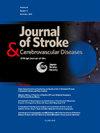Development and validation of clinical prediction model for functional independence measure following stroke rehabilitation
IF 2
4区 医学
Q3 NEUROSCIENCES
Journal of Stroke & Cerebrovascular Diseases
Pub Date : 2025-02-01
DOI:10.1016/j.jstrokecerebrovasdis.2024.108185
引用次数: 0
Abstract
Objectives
To develop and internally validate a clinical prediction model that includes balance ability and nutritional indices for the motor-functional independence measure (M-FIM) at 90 days post-stroke stroke.
Materials and Methods
This retrospective, single-center study included 566 patients with stroke undergoing rehabilitation at our rehabilitation hospital. The primary outcome was the M-FIM score of >61 at 3 months post-strokes onset. Stepwise conditional forward selection was first used to identify predictors for the achievement of M-FIM>61 at 90 days post-stroke, from 25 potential predictors at admission. The selected predictors were dichotomized with cut-off values to establish scoring systems, resulting in the B-ADL model, which includes postural balance (B), albumin level, age, arm function (A), days since stroke onset (D), and level of activities of daily living (ADL) (L). For internal validation, we corrected the optimism of the area under the curve of receiver operating characteristic curve (AUROC) induced by overfitting the original data using the bootstrap validation method. Calibration capacity was assessed using a calibration plot.
Results
We developed a clinical model to predict the M-FIM at 90 days post-stroke onset. The AUROC of the B-ADL model was 0.92 (sensitivity, 93.7%; specificity, 89.7%). The B-ADL model showed high accuracy with an AUROC of 0.970 in the internal validation. The scoring system in the validation cohort had a cut-off value of 5.5/12 points to predict the achievement of M-FIM>61 (AUROC: 0.950; 95% CI 0.930–0.970).
Conclusions
The B-ADL model accurately predicted M-FIM >61 at 90 days post-stroke on the day of admission to the recovery rehabilitation ward. The B-ADL model is useful for optimizing rehabilitation programs and resource allocation, allowing for targeted interventions after stroke.
中风康复后功能独立性测量临床预测模型的开发与验证。
目的:建立并内部验证一个包括平衡能力和营养指标的脑卒中后90天运动功能独立性测量(M-FIM)的临床预测模型。材料和方法:本回顾性、单中心研究纳入566例在我院接受康复治疗的脑卒中患者。主要终点为脑卒中后3个月M-FIM评分bbbb61。逐步条件前向选择首先用于从入院时的25个潜在预测因子中确定中风后90天达到M-FIM bbbb61的预测因子。将选择的预测因子用截断值进行二分类,建立评分系统,得到B-ADL模型,该模型包括姿势平衡(B)、白蛋白水平、年龄、手臂功能(A)、中风发病天数(D)和日常生活活动水平(ADL) (L)。为了进行内部验证,我们使用bootstrap验证方法修正了因原始数据过拟合而导致的受试者工作特征曲线(AUROC)曲线下面积的乐观性。使用校准图评估校准能力。结果:我们建立了一个临床模型来预测中风发作后90天的M-FIM。B-ADL模型的AUROC为0.92(敏感性为93.7%;特异性,89.7%)。在内部验证中,B-ADL模型具有较高的准确度,AUROC为0.970。验证队列的评分系统预测M-FIM实现的截断值为5.5/12分(AUROC: 0.950;95% ci 0.930-0.970)。结论:B-ADL模型准确预测脑卒中后90天的M-FIM bbb61。B-ADL模型有助于优化康复计划和资源分配,允许中风后的针对性干预。
本文章由计算机程序翻译,如有差异,请以英文原文为准。
求助全文
约1分钟内获得全文
求助全文
来源期刊

Journal of Stroke & Cerebrovascular Diseases
Medicine-Surgery
CiteScore
5.00
自引率
4.00%
发文量
583
审稿时长
62 days
期刊介绍:
The Journal of Stroke & Cerebrovascular Diseases publishes original papers on basic and clinical science related to the fields of stroke and cerebrovascular diseases. The Journal also features review articles, controversies, methods and technical notes, selected case reports and other original articles of special nature. Its editorial mission is to focus on prevention and repair of cerebrovascular disease. Clinical papers emphasize medical and surgical aspects of stroke, clinical trials and design, epidemiology, stroke care delivery systems and outcomes, imaging sciences and rehabilitation of stroke. The Journal will be of special interest to specialists involved in caring for patients with cerebrovascular disease, including neurologists, neurosurgeons and cardiologists.
 求助内容:
求助内容: 应助结果提醒方式:
应助结果提醒方式:


